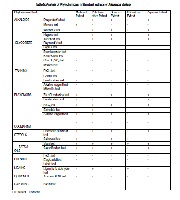In vitro preliminary screening of bioactive compounds of different parts of Adansonia digitata L. a globally endangered tree
Keywords:
Adansonia digitata, Phytochemical screening, Solvent extractsAbstract
The present investigation was undertaken to screen the different parts of Adansonia digitata L. for the presence of bioactive compounds. The preliminary phytochemical screening was performed by using various solvent extracts of different parts such as leaf, seed, fruit wall and floral parts of A. digitata. The phytochemical analysis of the dry seeds, leaf, floral extracts, fruit wall and bark of stem was carried out to determine the presence of bioactive compounds using the standard qualitative procedures. The phytochemical analysis revealed that all the solvent extracts of different parts were rich in possession of flavonoids, alkaloids, glycosides, tannins, sterols, phenols, saponins, coumarins and quinones. From the present study it can be concluded that extracts of different parts of this valuable tree can be utilized in the preparation of various active principles of medicines to alleviate many diseases.
References
Edeoga HO, Okwu DE, Mbaebie BO. Phytochemical constituents of some Nigerian
medicinal plants, Afr. J. Biotechnol. 2005; 4(7): 685-688.
Hadacek, F. Secondary metabolites as plant traits: current assessment and future
perspectives. CRC Crit. Rev. Plant Sci. 2002; 21, 273–322
Mann J. Secondary Metabolism. Oxford University press, London, 1978:154.
Sidibe M, Williams JT. Baobab Adansonia digitata. Southampton, UK: International
Centre for Under-utilised Crops, 2002.
Owen. The medico-social and cultural significance of Adansonia digitata (baobab) in
African communities. African Notes, 1970 6(1): 26-36.
Igboeli LC, Addy EOH, Salami LI. Effects of some processing techniques on the
antinutrient contents of baobab seeds (Adansonia digitata). Bioresource Technology, 1997;
:29-31.
Gebauer J, Siddig EIK, Ebert G. Baobab (Adansonia digtataL.): a Review on a
Multipurpose tree with Promising Future in the Sudan. Gartenbauwissenschaft, 2002; 67(4),
S, 155-160.
Harborne JB. Phytochemical methods guide to modern technique of plant analysis. 3rd
Edition, Chapmen all Hall, London, 1998.
Trease GE, Evans WC. Pharmacognosy. W.B Scandars Company Ltd. London. 1989; 14:
- 300
Sofowora. Medicinal Plant and Medicine in Africa, John Willey Spectrum, Ibadan Nigeria.
: 281 – 285.
Tatke PA. Isolation of marker compounds from medicinal plants with high purity: A
challenge for chemists. Proceedings of the Bandung International Conference on Medicinal
Chemistry, Aug. 6-8, School of Pharmacy, Bandung Institute of Technology, 2010 : 78-78.
Kubmarawa D, Ajoku G, Enwerem M, Okorie, D. “Preliminary Phytochemical and
Antimicrobial Screening of 50 Medicinal Plants from Nigeria”. African Journal of
Biotechnology. 2007; 6 (14):1690-1696.
Edoga HO, Okwu DE, Mbaebie BO. Phytochemicals constituents of some Nigerian
medicinal plants. Afr. J. Biotechnol, 2005; 4(7): 685-688.
Mojab F, Kamalinejad M, Ghaderi N, Vanidipour HR. Phytochemicals screening of some
species of Iranian plants. Iran. J. Pharm. Res, 2003; 3:77-82.
Parekh J, Chanda S. Antibacterial and phytochemical studies on twelve species of Indian
medicinal plants. Afr. J. Biomed. Res, 2007; 10: 175-181.
Parekh J, Chanda S. phytochemica screening of some plants from western
Region of India.Plant . Arch, 2008; 8: 657-662.



